Mac Robertson High School: Masters of Education - Situational and SWOT Analysis
VerifiedAdded on 2023/06/11
|13
|4365
|463
AI Summary
This report provides a situational analysis of Mac Robertson High School's Masters of Education program, including a SWOT analysis. The report discusses the political, economic, social, and technological factors that affect the program, as well as the strengths, weaknesses, opportunities, and threats of the program. The report also includes commentary on the analysis and recommendations for the program.
Contribute Materials
Your contribution can guide someone’s learning journey. Share your
documents today.
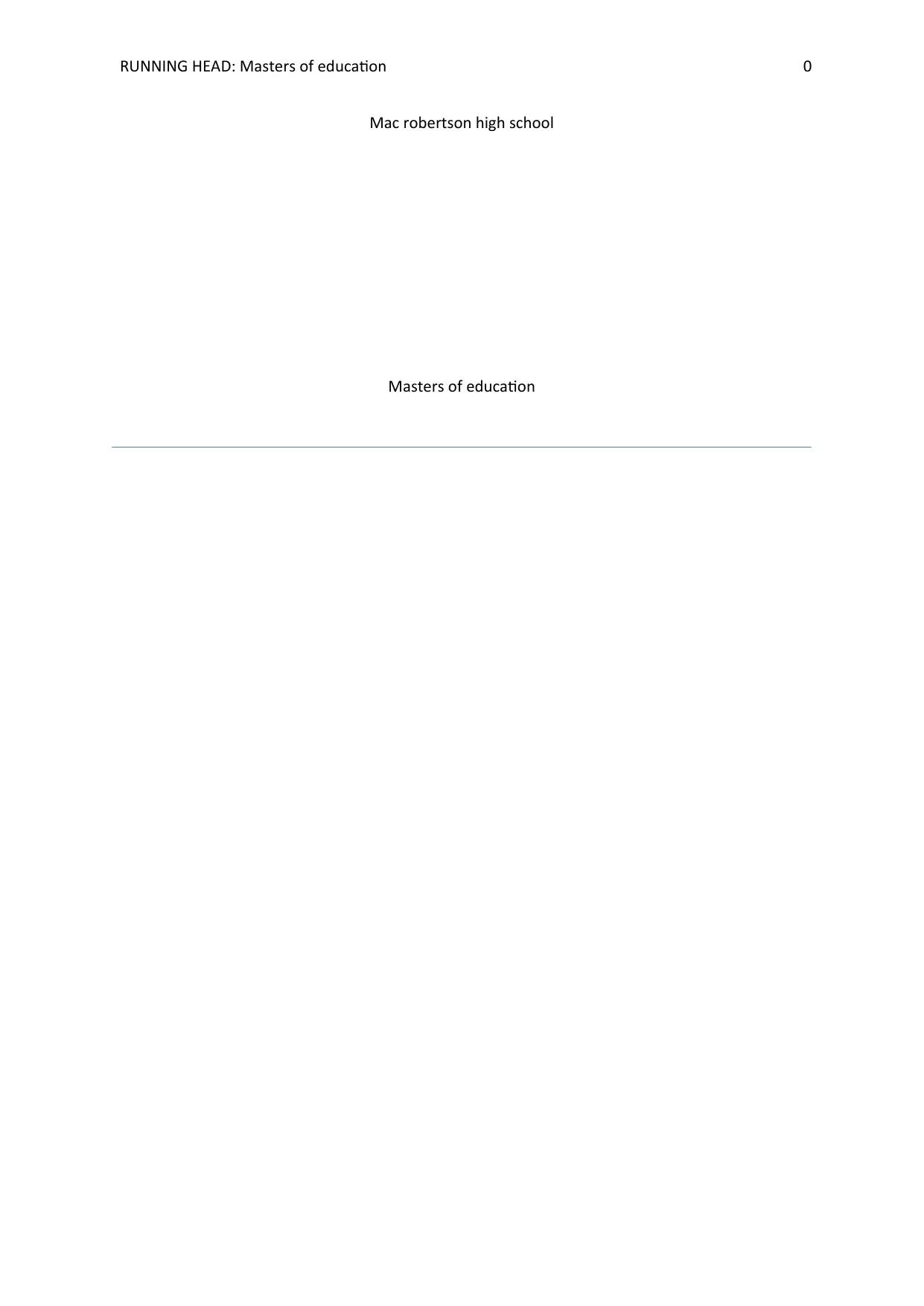
RUNNING HEAD: Masters of education 0
Mac robertson high school
Masters of education
Mac robertson high school
Masters of education
Secure Best Marks with AI Grader
Need help grading? Try our AI Grader for instant feedback on your assignments.
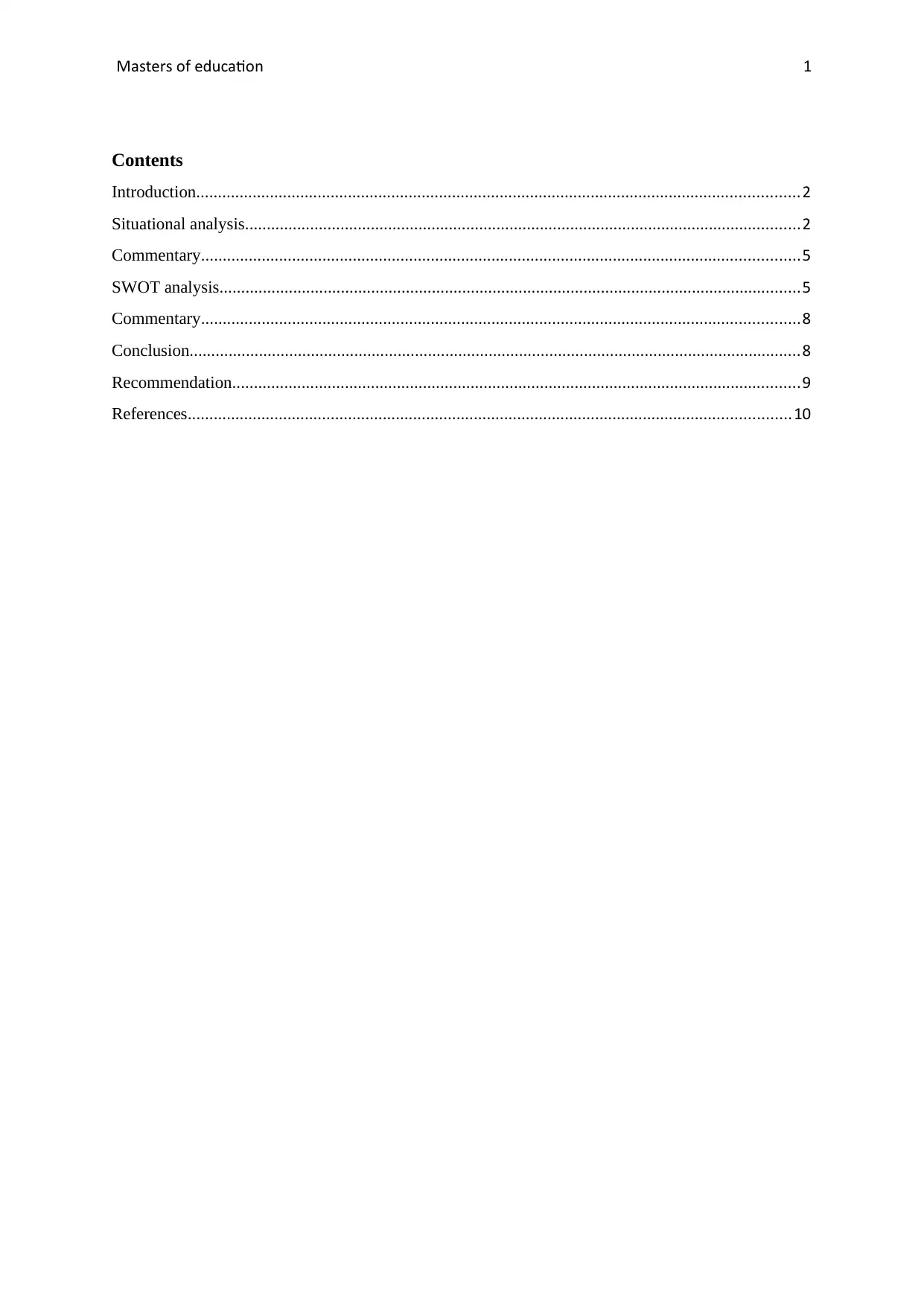
Masters of education 1
Contents
Introduction...........................................................................................................................................2
Situational analysis................................................................................................................................2
Commentary..........................................................................................................................................5
SWOT analysis......................................................................................................................................5
Commentary..........................................................................................................................................8
Conclusion.............................................................................................................................................8
Recommendation...................................................................................................................................9
References...........................................................................................................................................10
Contents
Introduction...........................................................................................................................................2
Situational analysis................................................................................................................................2
Commentary..........................................................................................................................................5
SWOT analysis......................................................................................................................................5
Commentary..........................................................................................................................................8
Conclusion.............................................................................................................................................8
Recommendation...................................................................................................................................9
References...........................................................................................................................................10
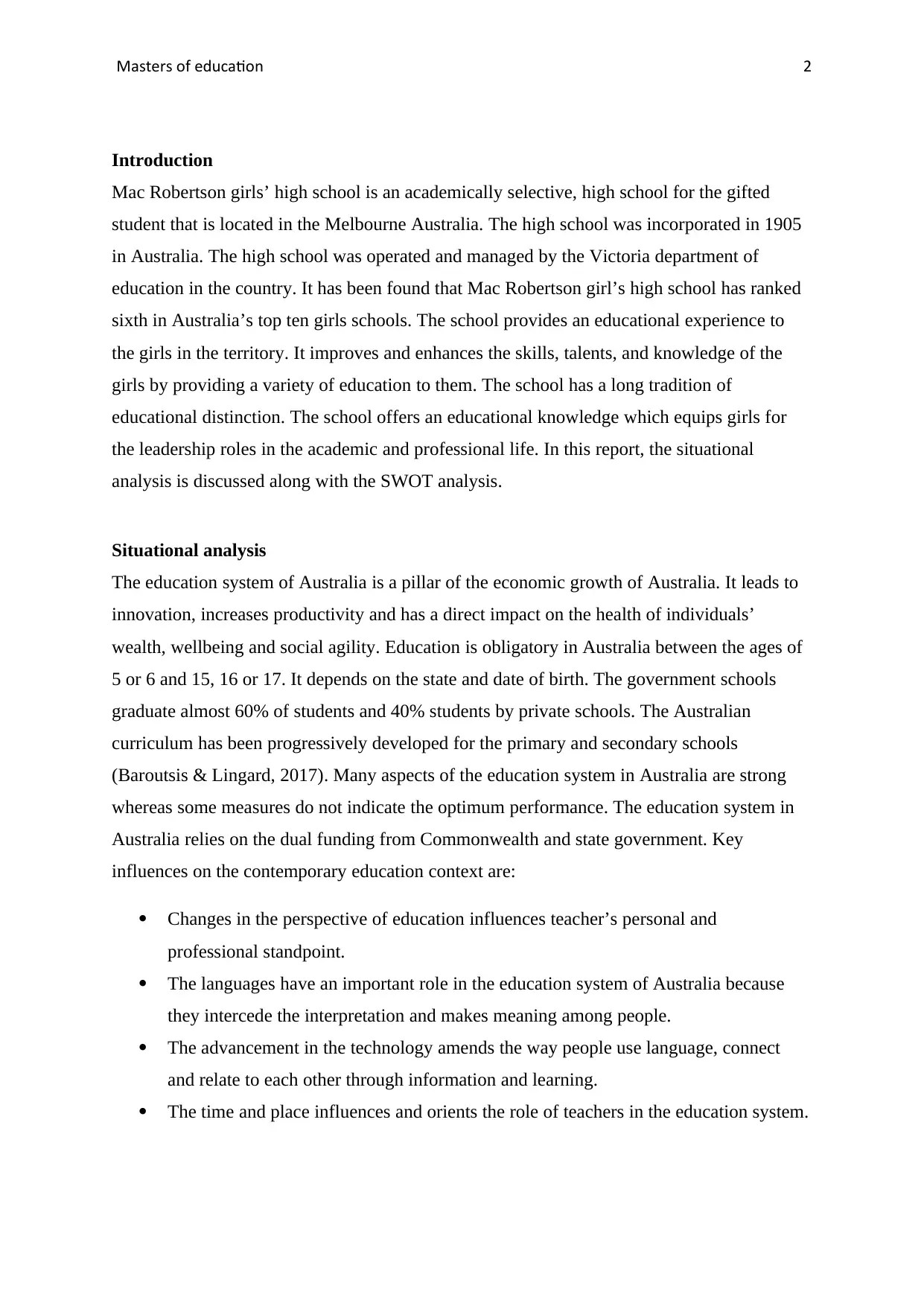
Masters of education 2
Introduction
Mac Robertson girls’ high school is an academically selective, high school for the gifted
student that is located in the Melbourne Australia. The high school was incorporated in 1905
in Australia. The high school was operated and managed by the Victoria department of
education in the country. It has been found that Mac Robertson girl’s high school has ranked
sixth in Australia’s top ten girls schools. The school provides an educational experience to
the girls in the territory. It improves and enhances the skills, talents, and knowledge of the
girls by providing a variety of education to them. The school has a long tradition of
educational distinction. The school offers an educational knowledge which equips girls for
the leadership roles in the academic and professional life. In this report, the situational
analysis is discussed along with the SWOT analysis.
Situational analysis
The education system of Australia is a pillar of the economic growth of Australia. It leads to
innovation, increases productivity and has a direct impact on the health of individuals’
wealth, wellbeing and social agility. Education is obligatory in Australia between the ages of
5 or 6 and 15, 16 or 17. It depends on the state and date of birth. The government schools
graduate almost 60% of students and 40% students by private schools. The Australian
curriculum has been progressively developed for the primary and secondary schools
(Baroutsis & Lingard, 2017). Many aspects of the education system in Australia are strong
whereas some measures do not indicate the optimum performance. The education system in
Australia relies on the dual funding from Commonwealth and state government. Key
influences on the contemporary education context are:
Changes in the perspective of education influences teacher’s personal and
professional standpoint.
The languages have an important role in the education system of Australia because
they intercede the interpretation and makes meaning among people.
The advancement in the technology amends the way people use language, connect
and relate to each other through information and learning.
The time and place influences and orients the role of teachers in the education system.
Introduction
Mac Robertson girls’ high school is an academically selective, high school for the gifted
student that is located in the Melbourne Australia. The high school was incorporated in 1905
in Australia. The high school was operated and managed by the Victoria department of
education in the country. It has been found that Mac Robertson girl’s high school has ranked
sixth in Australia’s top ten girls schools. The school provides an educational experience to
the girls in the territory. It improves and enhances the skills, talents, and knowledge of the
girls by providing a variety of education to them. The school has a long tradition of
educational distinction. The school offers an educational knowledge which equips girls for
the leadership roles in the academic and professional life. In this report, the situational
analysis is discussed along with the SWOT analysis.
Situational analysis
The education system of Australia is a pillar of the economic growth of Australia. It leads to
innovation, increases productivity and has a direct impact on the health of individuals’
wealth, wellbeing and social agility. Education is obligatory in Australia between the ages of
5 or 6 and 15, 16 or 17. It depends on the state and date of birth. The government schools
graduate almost 60% of students and 40% students by private schools. The Australian
curriculum has been progressively developed for the primary and secondary schools
(Baroutsis & Lingard, 2017). Many aspects of the education system in Australia are strong
whereas some measures do not indicate the optimum performance. The education system in
Australia relies on the dual funding from Commonwealth and state government. Key
influences on the contemporary education context are:
Changes in the perspective of education influences teacher’s personal and
professional standpoint.
The languages have an important role in the education system of Australia because
they intercede the interpretation and makes meaning among people.
The advancement in the technology amends the way people use language, connect
and relate to each other through information and learning.
The time and place influences and orients the role of teachers in the education system.
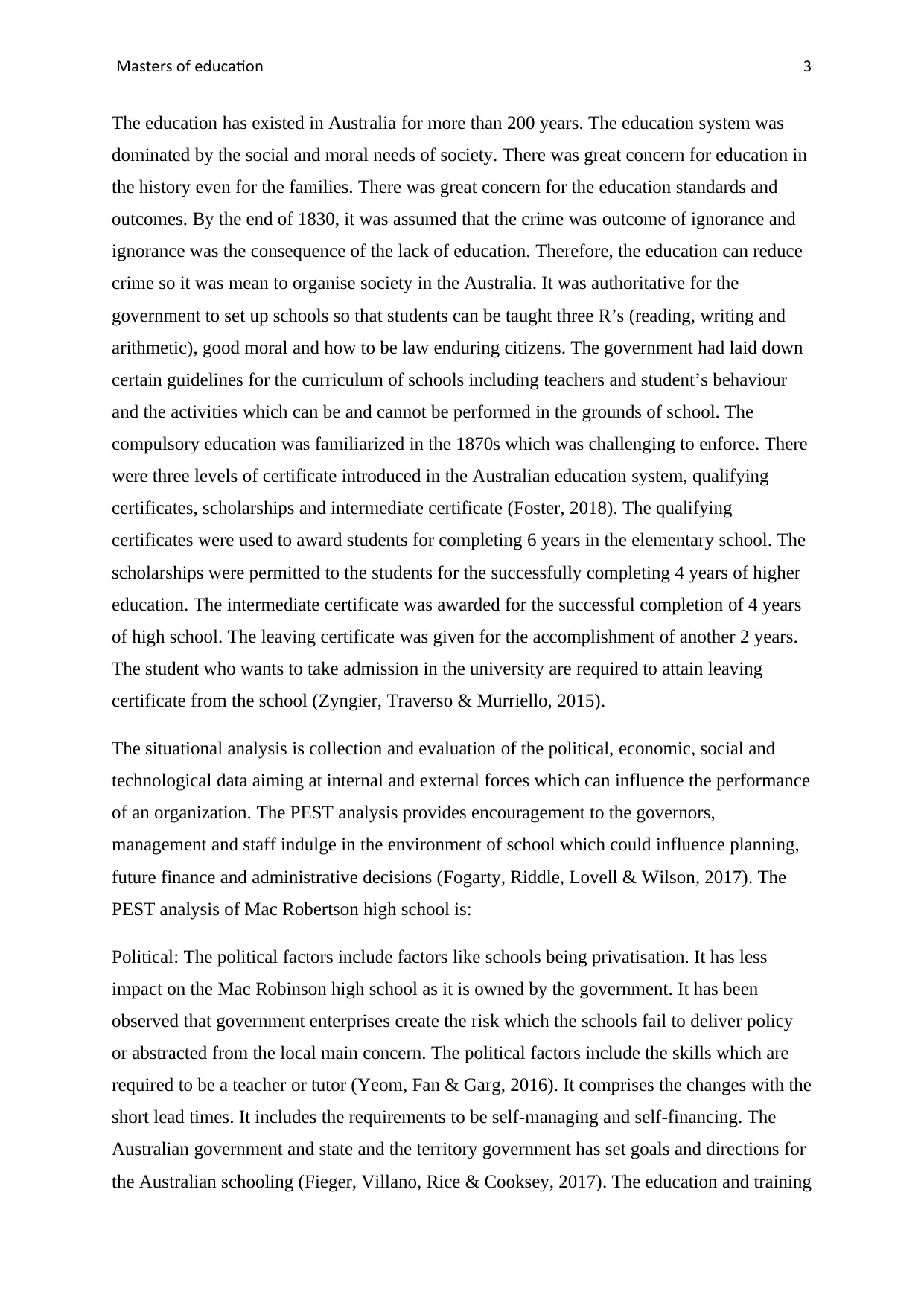
Masters of education 3
The education has existed in Australia for more than 200 years. The education system was
dominated by the social and moral needs of society. There was great concern for education in
the history even for the families. There was great concern for the education standards and
outcomes. By the end of 1830, it was assumed that the crime was outcome of ignorance and
ignorance was the consequence of the lack of education. Therefore, the education can reduce
crime so it was mean to organise society in the Australia. It was authoritative for the
government to set up schools so that students can be taught three R’s (reading, writing and
arithmetic), good moral and how to be law enduring citizens. The government had laid down
certain guidelines for the curriculum of schools including teachers and student’s behaviour
and the activities which can be and cannot be performed in the grounds of school. The
compulsory education was familiarized in the 1870s which was challenging to enforce. There
were three levels of certificate introduced in the Australian education system, qualifying
certificates, scholarships and intermediate certificate (Foster, 2018). The qualifying
certificates were used to award students for completing 6 years in the elementary school. The
scholarships were permitted to the students for the successfully completing 4 years of higher
education. The intermediate certificate was awarded for the successful completion of 4 years
of high school. The leaving certificate was given for the accomplishment of another 2 years.
The student who wants to take admission in the university are required to attain leaving
certificate from the school (Zyngier, Traverso & Murriello, 2015).
The situational analysis is collection and evaluation of the political, economic, social and
technological data aiming at internal and external forces which can influence the performance
of an organization. The PEST analysis provides encouragement to the governors,
management and staff indulge in the environment of school which could influence planning,
future finance and administrative decisions (Fogarty, Riddle, Lovell & Wilson, 2017). The
PEST analysis of Mac Robertson high school is:
Political: The political factors include factors like schools being privatisation. It has less
impact on the Mac Robinson high school as it is owned by the government. It has been
observed that government enterprises create the risk which the schools fail to deliver policy
or abstracted from the local main concern. The political factors include the skills which are
required to be a teacher or tutor (Yeom, Fan & Garg, 2016). It comprises the changes with the
short lead times. It includes the requirements to be self-managing and self-financing. The
Australian government and state and the territory government has set goals and directions for
the Australian schooling (Fieger, Villano, Rice & Cooksey, 2017). The education and training
The education has existed in Australia for more than 200 years. The education system was
dominated by the social and moral needs of society. There was great concern for education in
the history even for the families. There was great concern for the education standards and
outcomes. By the end of 1830, it was assumed that the crime was outcome of ignorance and
ignorance was the consequence of the lack of education. Therefore, the education can reduce
crime so it was mean to organise society in the Australia. It was authoritative for the
government to set up schools so that students can be taught three R’s (reading, writing and
arithmetic), good moral and how to be law enduring citizens. The government had laid down
certain guidelines for the curriculum of schools including teachers and student’s behaviour
and the activities which can be and cannot be performed in the grounds of school. The
compulsory education was familiarized in the 1870s which was challenging to enforce. There
were three levels of certificate introduced in the Australian education system, qualifying
certificates, scholarships and intermediate certificate (Foster, 2018). The qualifying
certificates were used to award students for completing 6 years in the elementary school. The
scholarships were permitted to the students for the successfully completing 4 years of higher
education. The intermediate certificate was awarded for the successful completion of 4 years
of high school. The leaving certificate was given for the accomplishment of another 2 years.
The student who wants to take admission in the university are required to attain leaving
certificate from the school (Zyngier, Traverso & Murriello, 2015).
The situational analysis is collection and evaluation of the political, economic, social and
technological data aiming at internal and external forces which can influence the performance
of an organization. The PEST analysis provides encouragement to the governors,
management and staff indulge in the environment of school which could influence planning,
future finance and administrative decisions (Fogarty, Riddle, Lovell & Wilson, 2017). The
PEST analysis of Mac Robertson high school is:
Political: The political factors include factors like schools being privatisation. It has less
impact on the Mac Robinson high school as it is owned by the government. It has been
observed that government enterprises create the risk which the schools fail to deliver policy
or abstracted from the local main concern. The political factors include the skills which are
required to be a teacher or tutor (Yeom, Fan & Garg, 2016). It comprises the changes with the
short lead times. It includes the requirements to be self-managing and self-financing. The
Australian government and state and the territory government has set goals and directions for
the Australian schooling (Fieger, Villano, Rice & Cooksey, 2017). The education and training
Secure Best Marks with AI Grader
Need help grading? Try our AI Grader for instant feedback on your assignments.
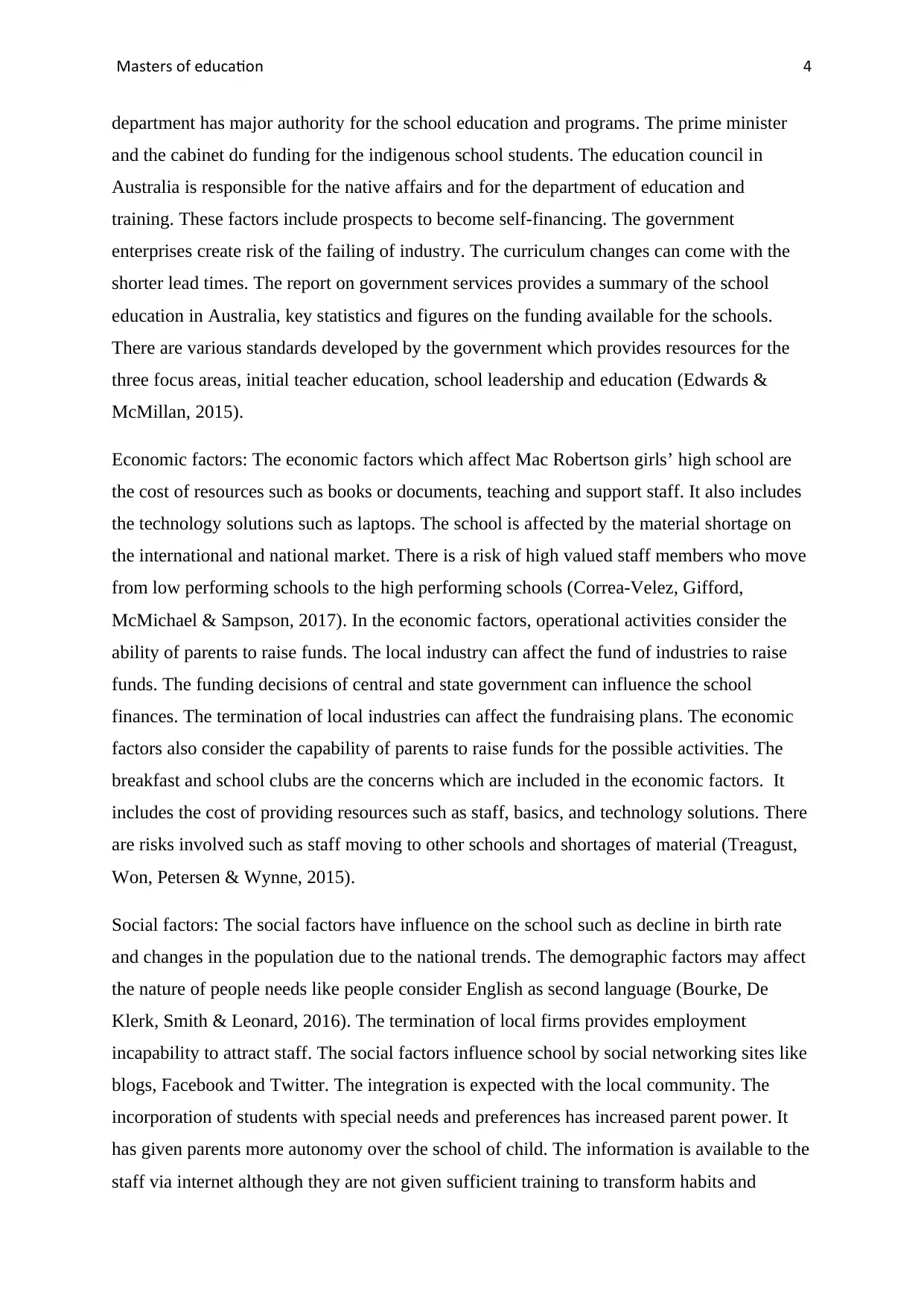
Masters of education 4
department has major authority for the school education and programs. The prime minister
and the cabinet do funding for the indigenous school students. The education council in
Australia is responsible for the native affairs and for the department of education and
training. These factors include prospects to become self-financing. The government
enterprises create risk of the failing of industry. The curriculum changes can come with the
shorter lead times. The report on government services provides a summary of the school
education in Australia, key statistics and figures on the funding available for the schools.
There are various standards developed by the government which provides resources for the
three focus areas, initial teacher education, school leadership and education (Edwards &
McMillan, 2015).
Economic factors: The economic factors which affect Mac Robertson girls’ high school are
the cost of resources such as books or documents, teaching and support staff. It also includes
the technology solutions such as laptops. The school is affected by the material shortage on
the international and national market. There is a risk of high valued staff members who move
from low performing schools to the high performing schools (Correa-Velez, Gifford,
McMichael & Sampson, 2017). In the economic factors, operational activities consider the
ability of parents to raise funds. The local industry can affect the fund of industries to raise
funds. The funding decisions of central and state government can influence the school
finances. The termination of local industries can affect the fundraising plans. The economic
factors also consider the capability of parents to raise funds for the possible activities. The
breakfast and school clubs are the concerns which are included in the economic factors. It
includes the cost of providing resources such as staff, basics, and technology solutions. There
are risks involved such as staff moving to other schools and shortages of material (Treagust,
Won, Petersen & Wynne, 2015).
Social factors: The social factors have influence on the school such as decline in birth rate
and changes in the population due to the national trends. The demographic factors may affect
the nature of people needs like people consider English as second language (Bourke, De
Klerk, Smith & Leonard, 2016). The termination of local firms provides employment
incapability to attract staff. The social factors influence school by social networking sites like
blogs, Facebook and Twitter. The integration is expected with the local community. The
incorporation of students with special needs and preferences has increased parent power. It
has given parents more autonomy over the school of child. The information is available to the
staff via internet although they are not given sufficient training to transform habits and
department has major authority for the school education and programs. The prime minister
and the cabinet do funding for the indigenous school students. The education council in
Australia is responsible for the native affairs and for the department of education and
training. These factors include prospects to become self-financing. The government
enterprises create risk of the failing of industry. The curriculum changes can come with the
shorter lead times. The report on government services provides a summary of the school
education in Australia, key statistics and figures on the funding available for the schools.
There are various standards developed by the government which provides resources for the
three focus areas, initial teacher education, school leadership and education (Edwards &
McMillan, 2015).
Economic factors: The economic factors which affect Mac Robertson girls’ high school are
the cost of resources such as books or documents, teaching and support staff. It also includes
the technology solutions such as laptops. The school is affected by the material shortage on
the international and national market. There is a risk of high valued staff members who move
from low performing schools to the high performing schools (Correa-Velez, Gifford,
McMichael & Sampson, 2017). In the economic factors, operational activities consider the
ability of parents to raise funds. The local industry can affect the fund of industries to raise
funds. The funding decisions of central and state government can influence the school
finances. The termination of local industries can affect the fundraising plans. The economic
factors also consider the capability of parents to raise funds for the possible activities. The
breakfast and school clubs are the concerns which are included in the economic factors. It
includes the cost of providing resources such as staff, basics, and technology solutions. There
are risks involved such as staff moving to other schools and shortages of material (Treagust,
Won, Petersen & Wynne, 2015).
Social factors: The social factors have influence on the school such as decline in birth rate
and changes in the population due to the national trends. The demographic factors may affect
the nature of people needs like people consider English as second language (Bourke, De
Klerk, Smith & Leonard, 2016). The termination of local firms provides employment
incapability to attract staff. The social factors influence school by social networking sites like
blogs, Facebook and Twitter. The integration is expected with the local community. The
incorporation of students with special needs and preferences has increased parent power. It
has given parents more autonomy over the school of child. The information is available to the
staff via internet although they are not given sufficient training to transform habits and
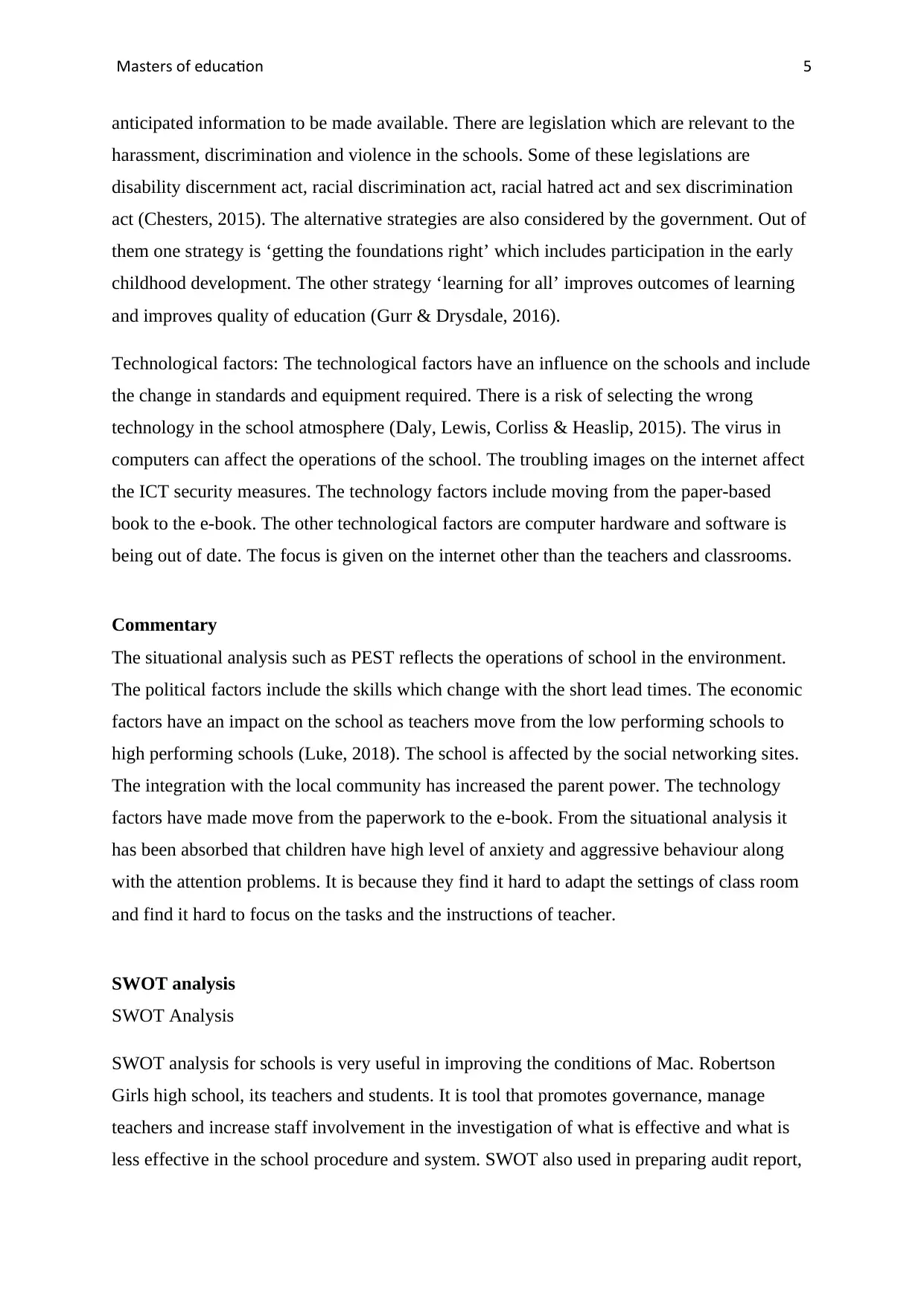
Masters of education 5
anticipated information to be made available. There are legislation which are relevant to the
harassment, discrimination and violence in the schools. Some of these legislations are
disability discernment act, racial discrimination act, racial hatred act and sex discrimination
act (Chesters, 2015). The alternative strategies are also considered by the government. Out of
them one strategy is ‘getting the foundations right’ which includes participation in the early
childhood development. The other strategy ‘learning for all’ improves outcomes of learning
and improves quality of education (Gurr & Drysdale, 2016).
Technological factors: The technological factors have an influence on the schools and include
the change in standards and equipment required. There is a risk of selecting the wrong
technology in the school atmosphere (Daly, Lewis, Corliss & Heaslip, 2015). The virus in
computers can affect the operations of the school. The troubling images on the internet affect
the ICT security measures. The technology factors include moving from the paper-based
book to the e-book. The other technological factors are computer hardware and software is
being out of date. The focus is given on the internet other than the teachers and classrooms.
Commentary
The situational analysis such as PEST reflects the operations of school in the environment.
The political factors include the skills which change with the short lead times. The economic
factors have an impact on the school as teachers move from the low performing schools to
high performing schools (Luke, 2018). The school is affected by the social networking sites.
The integration with the local community has increased the parent power. The technology
factors have made move from the paperwork to the e-book. From the situational analysis it
has been absorbed that children have high level of anxiety and aggressive behaviour along
with the attention problems. It is because they find it hard to adapt the settings of class room
and find it hard to focus on the tasks and the instructions of teacher.
SWOT analysis
SWOT Analysis
SWOT analysis for schools is very useful in improving the conditions of Mac. Robertson
Girls high school, its teachers and students. It is tool that promotes governance, manage
teachers and increase staff involvement in the investigation of what is effective and what is
less effective in the school procedure and system. SWOT also used in preparing audit report,
anticipated information to be made available. There are legislation which are relevant to the
harassment, discrimination and violence in the schools. Some of these legislations are
disability discernment act, racial discrimination act, racial hatred act and sex discrimination
act (Chesters, 2015). The alternative strategies are also considered by the government. Out of
them one strategy is ‘getting the foundations right’ which includes participation in the early
childhood development. The other strategy ‘learning for all’ improves outcomes of learning
and improves quality of education (Gurr & Drysdale, 2016).
Technological factors: The technological factors have an influence on the schools and include
the change in standards and equipment required. There is a risk of selecting the wrong
technology in the school atmosphere (Daly, Lewis, Corliss & Heaslip, 2015). The virus in
computers can affect the operations of the school. The troubling images on the internet affect
the ICT security measures. The technology factors include moving from the paper-based
book to the e-book. The other technological factors are computer hardware and software is
being out of date. The focus is given on the internet other than the teachers and classrooms.
Commentary
The situational analysis such as PEST reflects the operations of school in the environment.
The political factors include the skills which change with the short lead times. The economic
factors have an impact on the school as teachers move from the low performing schools to
high performing schools (Luke, 2018). The school is affected by the social networking sites.
The integration with the local community has increased the parent power. The technology
factors have made move from the paperwork to the e-book. From the situational analysis it
has been absorbed that children have high level of anxiety and aggressive behaviour along
with the attention problems. It is because they find it hard to adapt the settings of class room
and find it hard to focus on the tasks and the instructions of teacher.
SWOT analysis
SWOT Analysis
SWOT analysis for schools is very useful in improving the conditions of Mac. Robertson
Girls high school, its teachers and students. It is tool that promotes governance, manage
teachers and increase staff involvement in the investigation of what is effective and what is
less effective in the school procedure and system. SWOT also used in preparing audit report,
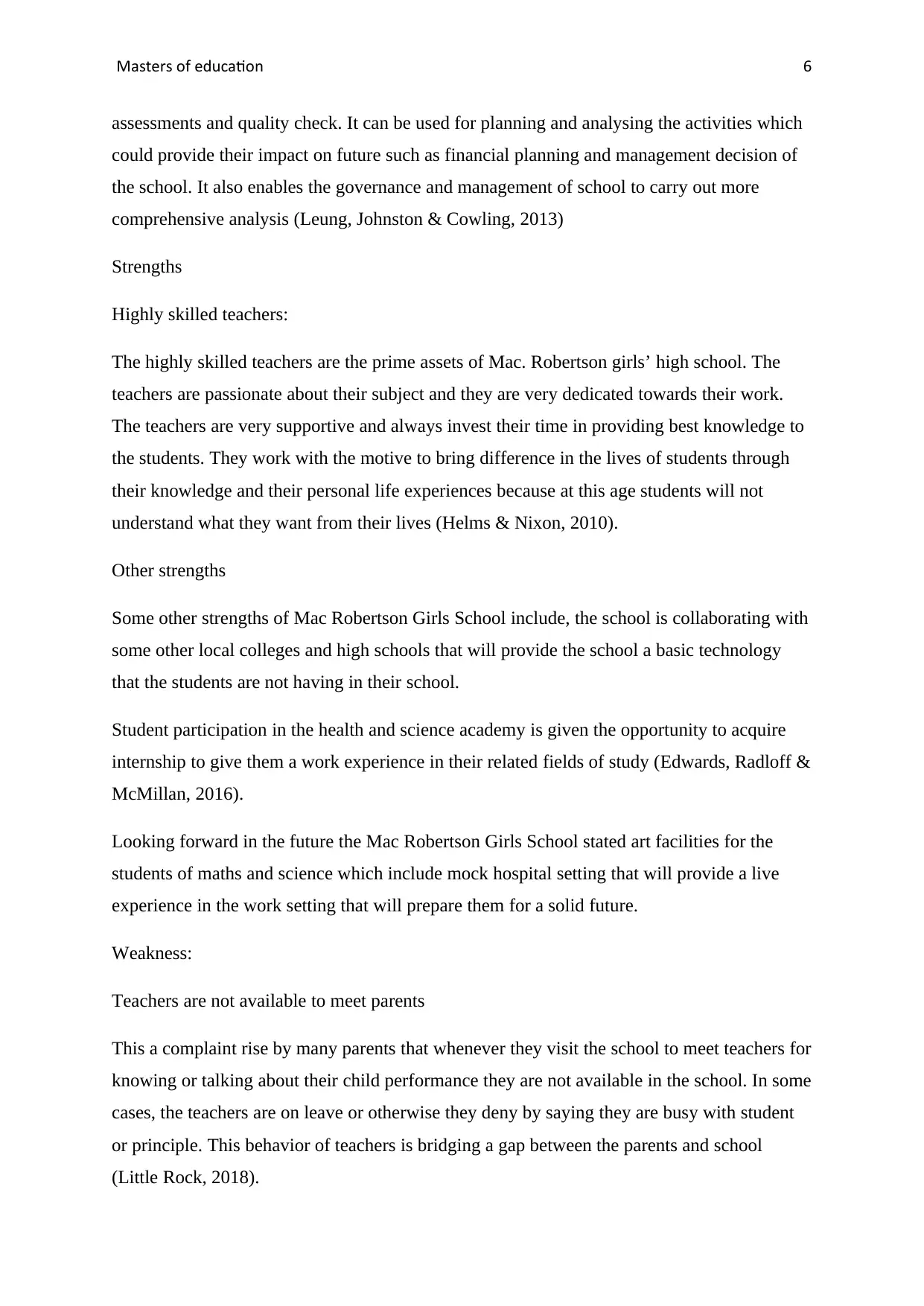
Masters of education 6
assessments and quality check. It can be used for planning and analysing the activities which
could provide their impact on future such as financial planning and management decision of
the school. It also enables the governance and management of school to carry out more
comprehensive analysis (Leung, Johnston & Cowling, 2013)
Strengths
Highly skilled teachers:
The highly skilled teachers are the prime assets of Mac. Robertson girls’ high school. The
teachers are passionate about their subject and they are very dedicated towards their work.
The teachers are very supportive and always invest their time in providing best knowledge to
the students. They work with the motive to bring difference in the lives of students through
their knowledge and their personal life experiences because at this age students will not
understand what they want from their lives (Helms & Nixon, 2010).
Other strengths
Some other strengths of Mac Robertson Girls School include, the school is collaborating with
some other local colleges and high schools that will provide the school a basic technology
that the students are not having in their school.
Student participation in the health and science academy is given the opportunity to acquire
internship to give them a work experience in their related fields of study (Edwards, Radloff &
McMillan, 2016).
Looking forward in the future the Mac Robertson Girls School stated art facilities for the
students of maths and science which include mock hospital setting that will provide a live
experience in the work setting that will prepare them for a solid future.
Weakness:
Teachers are not available to meet parents
This a complaint rise by many parents that whenever they visit the school to meet teachers for
knowing or talking about their child performance they are not available in the school. In some
cases, the teachers are on leave or otherwise they deny by saying they are busy with student
or principle. This behavior of teachers is bridging a gap between the parents and school
(Little Rock, 2018).
assessments and quality check. It can be used for planning and analysing the activities which
could provide their impact on future such as financial planning and management decision of
the school. It also enables the governance and management of school to carry out more
comprehensive analysis (Leung, Johnston & Cowling, 2013)
Strengths
Highly skilled teachers:
The highly skilled teachers are the prime assets of Mac. Robertson girls’ high school. The
teachers are passionate about their subject and they are very dedicated towards their work.
The teachers are very supportive and always invest their time in providing best knowledge to
the students. They work with the motive to bring difference in the lives of students through
their knowledge and their personal life experiences because at this age students will not
understand what they want from their lives (Helms & Nixon, 2010).
Other strengths
Some other strengths of Mac Robertson Girls School include, the school is collaborating with
some other local colleges and high schools that will provide the school a basic technology
that the students are not having in their school.
Student participation in the health and science academy is given the opportunity to acquire
internship to give them a work experience in their related fields of study (Edwards, Radloff &
McMillan, 2016).
Looking forward in the future the Mac Robertson Girls School stated art facilities for the
students of maths and science which include mock hospital setting that will provide a live
experience in the work setting that will prepare them for a solid future.
Weakness:
Teachers are not available to meet parents
This a complaint rise by many parents that whenever they visit the school to meet teachers for
knowing or talking about their child performance they are not available in the school. In some
cases, the teachers are on leave or otherwise they deny by saying they are busy with student
or principle. This behavior of teachers is bridging a gap between the parents and school
(Little Rock, 2018).
Paraphrase This Document
Need a fresh take? Get an instant paraphrase of this document with our AI Paraphraser
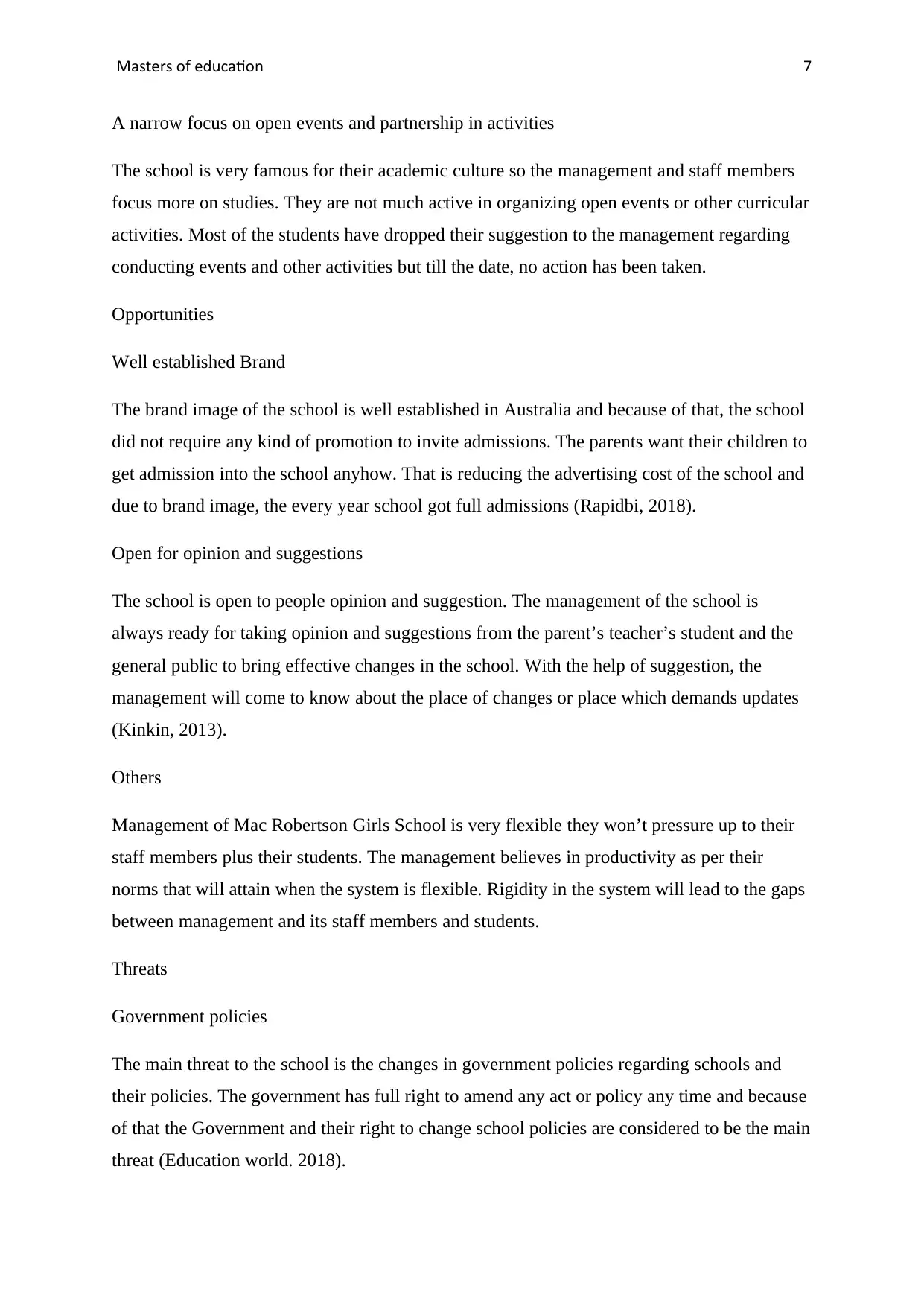
Masters of education 7
A narrow focus on open events and partnership in activities
The school is very famous for their academic culture so the management and staff members
focus more on studies. They are not much active in organizing open events or other curricular
activities. Most of the students have dropped their suggestion to the management regarding
conducting events and other activities but till the date, no action has been taken.
Opportunities
Well established Brand
The brand image of the school is well established in Australia and because of that, the school
did not require any kind of promotion to invite admissions. The parents want their children to
get admission into the school anyhow. That is reducing the advertising cost of the school and
due to brand image, the every year school got full admissions (Rapidbi, 2018).
Open for opinion and suggestions
The school is open to people opinion and suggestion. The management of the school is
always ready for taking opinion and suggestions from the parent’s teacher’s student and the
general public to bring effective changes in the school. With the help of suggestion, the
management will come to know about the place of changes or place which demands updates
(Kinkin, 2013).
Others
Management of Mac Robertson Girls School is very flexible they won’t pressure up to their
staff members plus their students. The management believes in productivity as per their
norms that will attain when the system is flexible. Rigidity in the system will lead to the gaps
between management and its staff members and students.
Threats
Government policies
The main threat to the school is the changes in government policies regarding schools and
their policies. The government has full right to amend any act or policy any time and because
of that the Government and their right to change school policies are considered to be the main
threat (Education world. 2018).
A narrow focus on open events and partnership in activities
The school is very famous for their academic culture so the management and staff members
focus more on studies. They are not much active in organizing open events or other curricular
activities. Most of the students have dropped their suggestion to the management regarding
conducting events and other activities but till the date, no action has been taken.
Opportunities
Well established Brand
The brand image of the school is well established in Australia and because of that, the school
did not require any kind of promotion to invite admissions. The parents want their children to
get admission into the school anyhow. That is reducing the advertising cost of the school and
due to brand image, the every year school got full admissions (Rapidbi, 2018).
Open for opinion and suggestions
The school is open to people opinion and suggestion. The management of the school is
always ready for taking opinion and suggestions from the parent’s teacher’s student and the
general public to bring effective changes in the school. With the help of suggestion, the
management will come to know about the place of changes or place which demands updates
(Kinkin, 2013).
Others
Management of Mac Robertson Girls School is very flexible they won’t pressure up to their
staff members plus their students. The management believes in productivity as per their
norms that will attain when the system is flexible. Rigidity in the system will lead to the gaps
between management and its staff members and students.
Threats
Government policies
The main threat to the school is the changes in government policies regarding schools and
their policies. The government has full right to amend any act or policy any time and because
of that the Government and their right to change school policies are considered to be the main
threat (Education world. 2018).
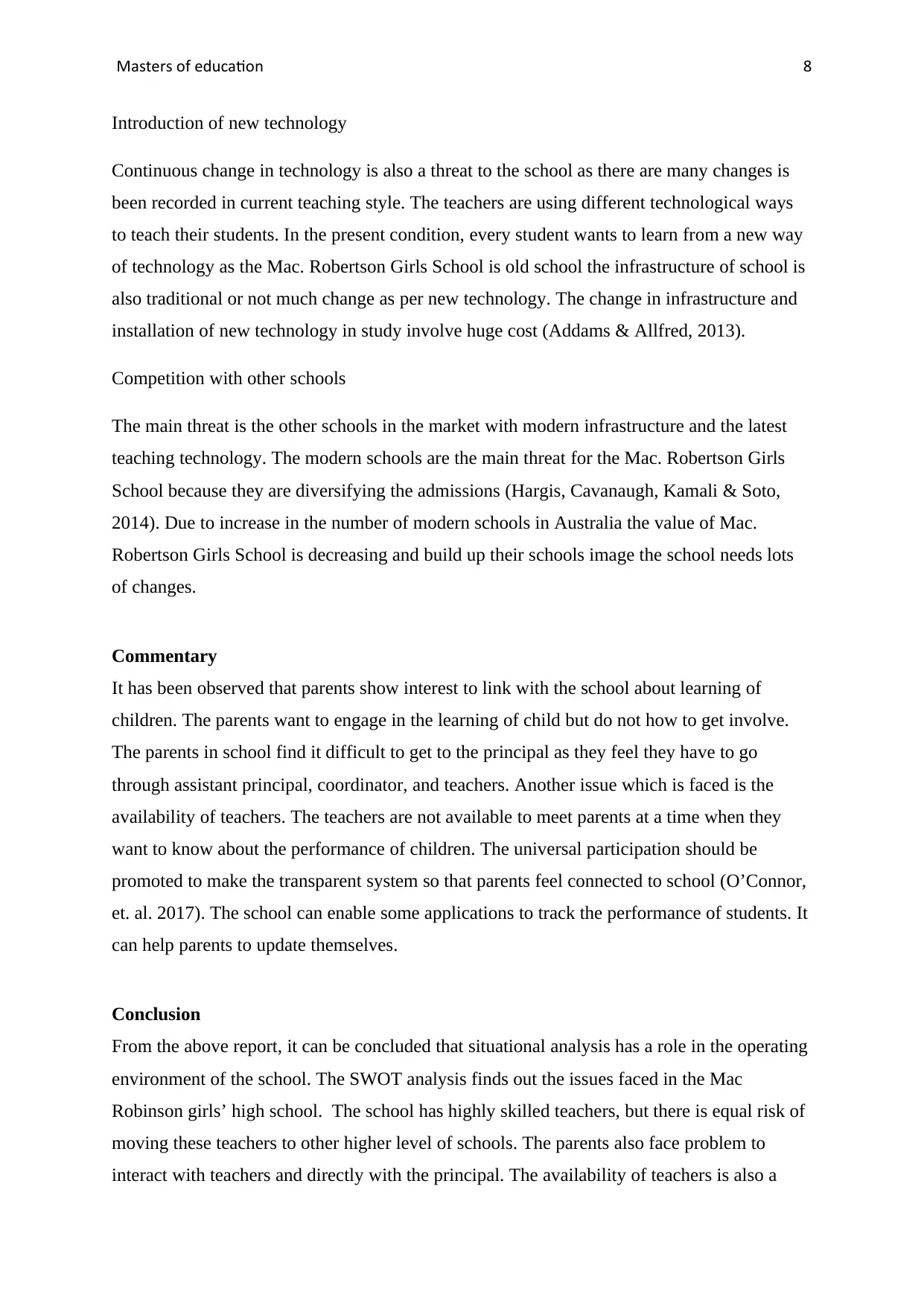
Masters of education 8
Introduction of new technology
Continuous change in technology is also a threat to the school as there are many changes is
been recorded in current teaching style. The teachers are using different technological ways
to teach their students. In the present condition, every student wants to learn from a new way
of technology as the Mac. Robertson Girls School is old school the infrastructure of school is
also traditional or not much change as per new technology. The change in infrastructure and
installation of new technology in study involve huge cost (Addams & Allfred, 2013).
Competition with other schools
The main threat is the other schools in the market with modern infrastructure and the latest
teaching technology. The modern schools are the main threat for the Mac. Robertson Girls
School because they are diversifying the admissions (Hargis, Cavanaugh, Kamali & Soto,
2014). Due to increase in the number of modern schools in Australia the value of Mac.
Robertson Girls School is decreasing and build up their schools image the school needs lots
of changes.
Commentary
It has been observed that parents show interest to link with the school about learning of
children. The parents want to engage in the learning of child but do not how to get involve.
The parents in school find it difficult to get to the principal as they feel they have to go
through assistant principal, coordinator, and teachers. Another issue which is faced is the
availability of teachers. The teachers are not available to meet parents at a time when they
want to know about the performance of children. The universal participation should be
promoted to make the transparent system so that parents feel connected to school (O’Connor,
et. al. 2017). The school can enable some applications to track the performance of students. It
can help parents to update themselves.
Conclusion
From the above report, it can be concluded that situational analysis has a role in the operating
environment of the school. The SWOT analysis finds out the issues faced in the Mac
Robinson girls’ high school. The school has highly skilled teachers, but there is equal risk of
moving these teachers to other higher level of schools. The parents also face problem to
interact with teachers and directly with the principal. The availability of teachers is also a
Introduction of new technology
Continuous change in technology is also a threat to the school as there are many changes is
been recorded in current teaching style. The teachers are using different technological ways
to teach their students. In the present condition, every student wants to learn from a new way
of technology as the Mac. Robertson Girls School is old school the infrastructure of school is
also traditional or not much change as per new technology. The change in infrastructure and
installation of new technology in study involve huge cost (Addams & Allfred, 2013).
Competition with other schools
The main threat is the other schools in the market with modern infrastructure and the latest
teaching technology. The modern schools are the main threat for the Mac. Robertson Girls
School because they are diversifying the admissions (Hargis, Cavanaugh, Kamali & Soto,
2014). Due to increase in the number of modern schools in Australia the value of Mac.
Robertson Girls School is decreasing and build up their schools image the school needs lots
of changes.
Commentary
It has been observed that parents show interest to link with the school about learning of
children. The parents want to engage in the learning of child but do not how to get involve.
The parents in school find it difficult to get to the principal as they feel they have to go
through assistant principal, coordinator, and teachers. Another issue which is faced is the
availability of teachers. The teachers are not available to meet parents at a time when they
want to know about the performance of children. The universal participation should be
promoted to make the transparent system so that parents feel connected to school (O’Connor,
et. al. 2017). The school can enable some applications to track the performance of students. It
can help parents to update themselves.
Conclusion
From the above report, it can be concluded that situational analysis has a role in the operating
environment of the school. The SWOT analysis finds out the issues faced in the Mac
Robinson girls’ high school. The school has highly skilled teachers, but there is equal risk of
moving these teachers to other higher level of schools. The parents also face problem to
interact with teachers and directly with the principal. The availability of teachers is also a
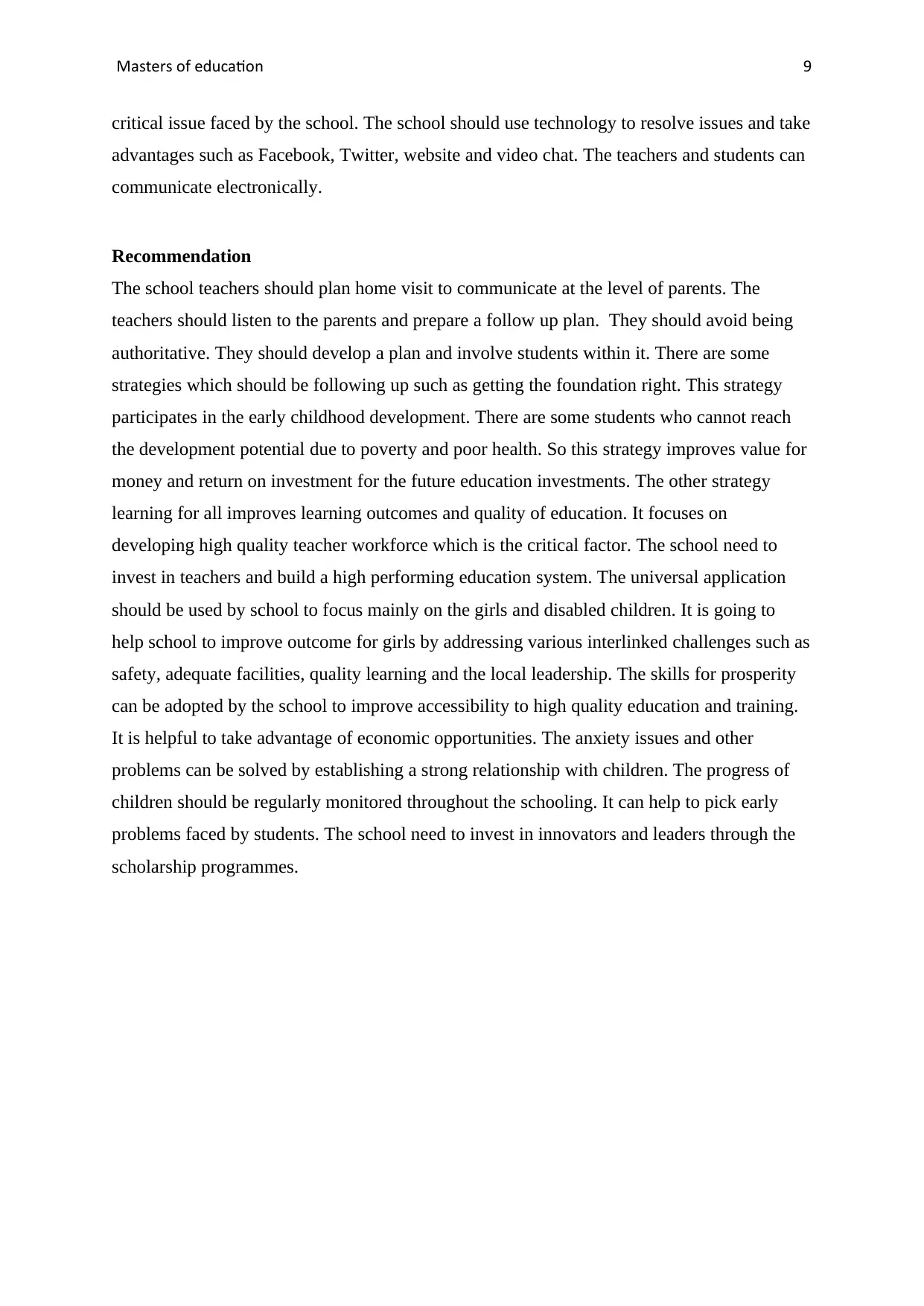
Masters of education 9
critical issue faced by the school. The school should use technology to resolve issues and take
advantages such as Facebook, Twitter, website and video chat. The teachers and students can
communicate electronically.
Recommendation
The school teachers should plan home visit to communicate at the level of parents. The
teachers should listen to the parents and prepare a follow up plan. They should avoid being
authoritative. They should develop a plan and involve students within it. There are some
strategies which should be following up such as getting the foundation right. This strategy
participates in the early childhood development. There are some students who cannot reach
the development potential due to poverty and poor health. So this strategy improves value for
money and return on investment for the future education investments. The other strategy
learning for all improves learning outcomes and quality of education. It focuses on
developing high quality teacher workforce which is the critical factor. The school need to
invest in teachers and build a high performing education system. The universal application
should be used by school to focus mainly on the girls and disabled children. It is going to
help school to improve outcome for girls by addressing various interlinked challenges such as
safety, adequate facilities, quality learning and the local leadership. The skills for prosperity
can be adopted by the school to improve accessibility to high quality education and training.
It is helpful to take advantage of economic opportunities. The anxiety issues and other
problems can be solved by establishing a strong relationship with children. The progress of
children should be regularly monitored throughout the schooling. It can help to pick early
problems faced by students. The school need to invest in innovators and leaders through the
scholarship programmes.
critical issue faced by the school. The school should use technology to resolve issues and take
advantages such as Facebook, Twitter, website and video chat. The teachers and students can
communicate electronically.
Recommendation
The school teachers should plan home visit to communicate at the level of parents. The
teachers should listen to the parents and prepare a follow up plan. They should avoid being
authoritative. They should develop a plan and involve students within it. There are some
strategies which should be following up such as getting the foundation right. This strategy
participates in the early childhood development. There are some students who cannot reach
the development potential due to poverty and poor health. So this strategy improves value for
money and return on investment for the future education investments. The other strategy
learning for all improves learning outcomes and quality of education. It focuses on
developing high quality teacher workforce which is the critical factor. The school need to
invest in teachers and build a high performing education system. The universal application
should be used by school to focus mainly on the girls and disabled children. It is going to
help school to improve outcome for girls by addressing various interlinked challenges such as
safety, adequate facilities, quality learning and the local leadership. The skills for prosperity
can be adopted by the school to improve accessibility to high quality education and training.
It is helpful to take advantage of economic opportunities. The anxiety issues and other
problems can be solved by establishing a strong relationship with children. The progress of
children should be regularly monitored throughout the schooling. It can help to pick early
problems faced by students. The school need to invest in innovators and leaders through the
scholarship programmes.
Secure Best Marks with AI Grader
Need help grading? Try our AI Grader for instant feedback on your assignments.
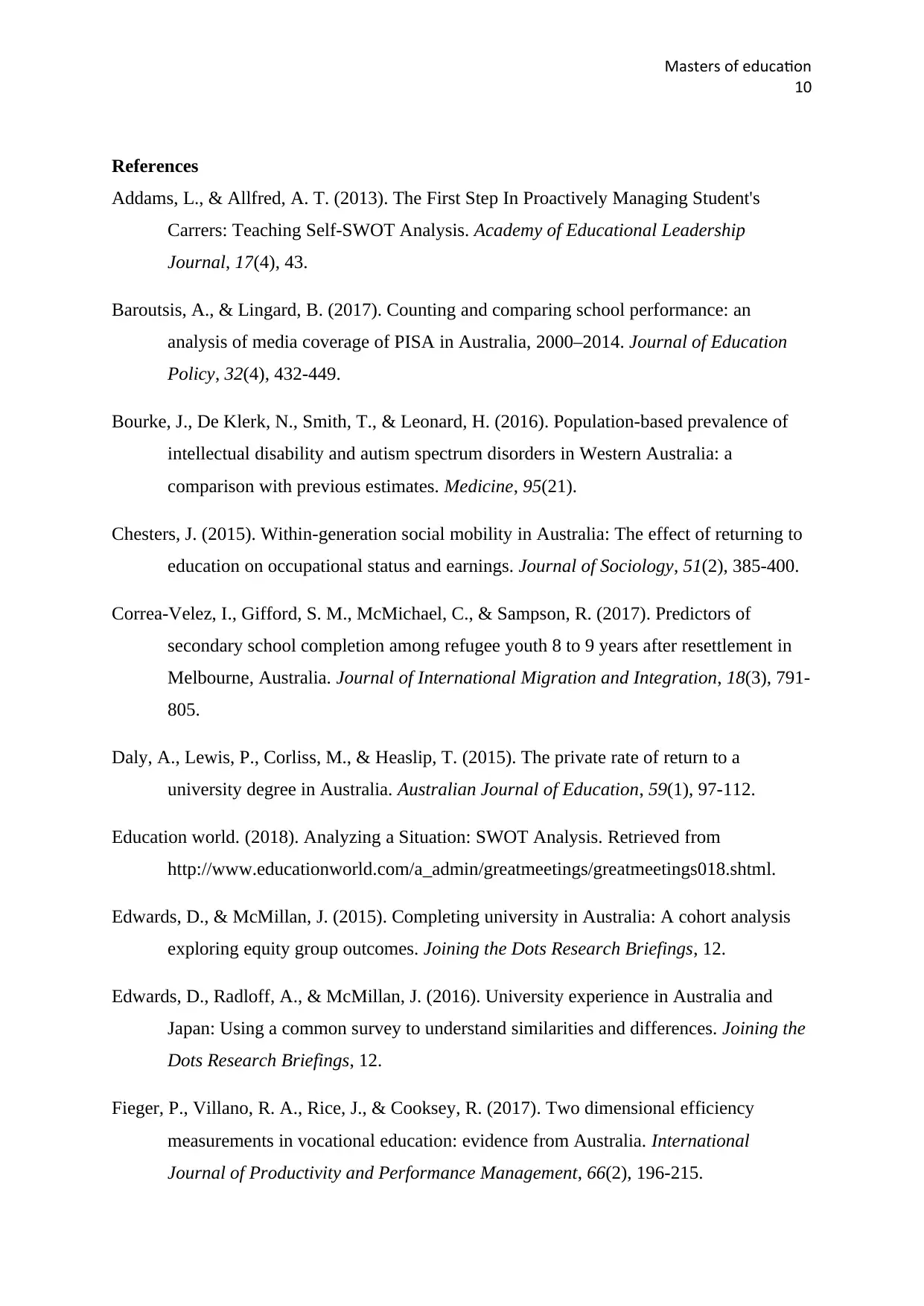
Masters of education
10
References
Addams, L., & Allfred, A. T. (2013). The First Step In Proactively Managing Student's
Carrers: Teaching Self-SWOT Analysis. Academy of Educational Leadership
Journal, 17(4), 43.
Baroutsis, A., & Lingard, B. (2017). Counting and comparing school performance: an
analysis of media coverage of PISA in Australia, 2000–2014. Journal of Education
Policy, 32(4), 432-449.
Bourke, J., De Klerk, N., Smith, T., & Leonard, H. (2016). Population-based prevalence of
intellectual disability and autism spectrum disorders in Western Australia: a
comparison with previous estimates. Medicine, 95(21).
Chesters, J. (2015). Within-generation social mobility in Australia: The effect of returning to
education on occupational status and earnings. Journal of Sociology, 51(2), 385-400.
Correa-Velez, I., Gifford, S. M., McMichael, C., & Sampson, R. (2017). Predictors of
secondary school completion among refugee youth 8 to 9 years after resettlement in
Melbourne, Australia. Journal of International Migration and Integration, 18(3), 791-
805.
Daly, A., Lewis, P., Corliss, M., & Heaslip, T. (2015). The private rate of return to a
university degree in Australia. Australian Journal of Education, 59(1), 97-112.
Education world. (2018). Analyzing a Situation: SWOT Analysis. Retrieved from
http://www.educationworld.com/a_admin/greatmeetings/greatmeetings018.shtml.
Edwards, D., & McMillan, J. (2015). Completing university in Australia: A cohort analysis
exploring equity group outcomes. Joining the Dots Research Briefings, 12.
Edwards, D., Radloff, A., & McMillan, J. (2016). University experience in Australia and
Japan: Using a common survey to understand similarities and differences. Joining the
Dots Research Briefings, 12.
Fieger, P., Villano, R. A., Rice, J., & Cooksey, R. (2017). Two dimensional efficiency
measurements in vocational education: evidence from Australia. International
Journal of Productivity and Performance Management, 66(2), 196-215.
10
References
Addams, L., & Allfred, A. T. (2013). The First Step In Proactively Managing Student's
Carrers: Teaching Self-SWOT Analysis. Academy of Educational Leadership
Journal, 17(4), 43.
Baroutsis, A., & Lingard, B. (2017). Counting and comparing school performance: an
analysis of media coverage of PISA in Australia, 2000–2014. Journal of Education
Policy, 32(4), 432-449.
Bourke, J., De Klerk, N., Smith, T., & Leonard, H. (2016). Population-based prevalence of
intellectual disability and autism spectrum disorders in Western Australia: a
comparison with previous estimates. Medicine, 95(21).
Chesters, J. (2015). Within-generation social mobility in Australia: The effect of returning to
education on occupational status and earnings. Journal of Sociology, 51(2), 385-400.
Correa-Velez, I., Gifford, S. M., McMichael, C., & Sampson, R. (2017). Predictors of
secondary school completion among refugee youth 8 to 9 years after resettlement in
Melbourne, Australia. Journal of International Migration and Integration, 18(3), 791-
805.
Daly, A., Lewis, P., Corliss, M., & Heaslip, T. (2015). The private rate of return to a
university degree in Australia. Australian Journal of Education, 59(1), 97-112.
Education world. (2018). Analyzing a Situation: SWOT Analysis. Retrieved from
http://www.educationworld.com/a_admin/greatmeetings/greatmeetings018.shtml.
Edwards, D., & McMillan, J. (2015). Completing university in Australia: A cohort analysis
exploring equity group outcomes. Joining the Dots Research Briefings, 12.
Edwards, D., Radloff, A., & McMillan, J. (2016). University experience in Australia and
Japan: Using a common survey to understand similarities and differences. Joining the
Dots Research Briefings, 12.
Fieger, P., Villano, R. A., Rice, J., & Cooksey, R. (2017). Two dimensional efficiency
measurements in vocational education: evidence from Australia. International
Journal of Productivity and Performance Management, 66(2), 196-215.
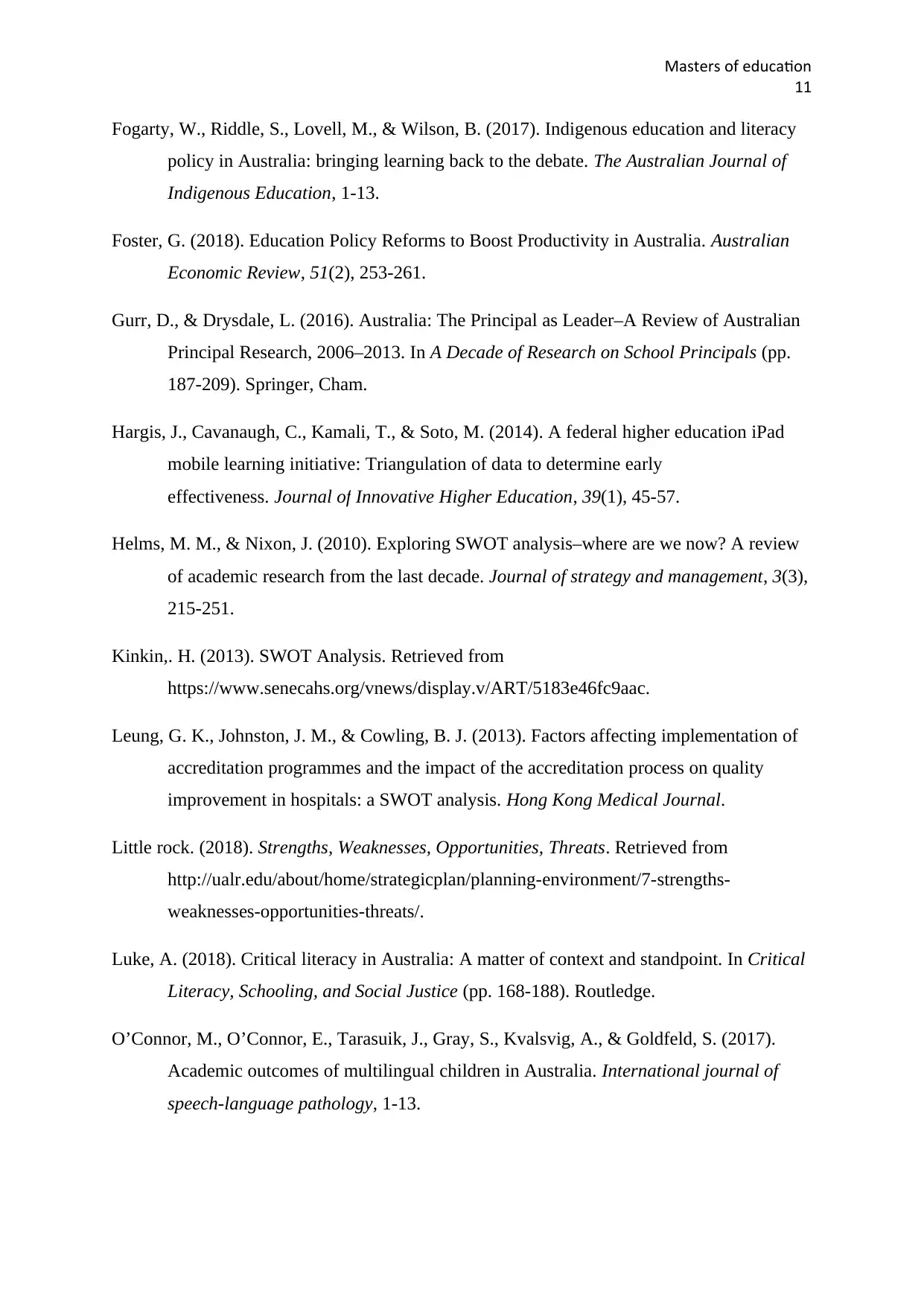
Masters of education
11
Fogarty, W., Riddle, S., Lovell, M., & Wilson, B. (2017). Indigenous education and literacy
policy in Australia: bringing learning back to the debate. The Australian Journal of
Indigenous Education, 1-13.
Foster, G. (2018). Education Policy Reforms to Boost Productivity in Australia. Australian
Economic Review, 51(2), 253-261.
Gurr, D., & Drysdale, L. (2016). Australia: The Principal as Leader–A Review of Australian
Principal Research, 2006–2013. In A Decade of Research on School Principals (pp.
187-209). Springer, Cham.
Hargis, J., Cavanaugh, C., Kamali, T., & Soto, M. (2014). A federal higher education iPad
mobile learning initiative: Triangulation of data to determine early
effectiveness. Journal of Innovative Higher Education, 39(1), 45-57.
Helms, M. M., & Nixon, J. (2010). Exploring SWOT analysis–where are we now? A review
of academic research from the last decade. Journal of strategy and management, 3(3),
215-251.
Kinkin,. H. (2013). SWOT Analysis. Retrieved from
https://www.senecahs.org/vnews/display.v/ART/5183e46fc9aac.
Leung, G. K., Johnston, J. M., & Cowling, B. J. (2013). Factors affecting implementation of
accreditation programmes and the impact of the accreditation process on quality
improvement in hospitals: a SWOT analysis. Hong Kong Medical Journal.
Little rock. (2018). Strengths, Weaknesses, Opportunities, Threats. Retrieved from
http://ualr.edu/about/home/strategicplan/planning-environment/7-strengths-
weaknesses-opportunities-threats/.
Luke, A. (2018). Critical literacy in Australia: A matter of context and standpoint. In Critical
Literacy, Schooling, and Social Justice (pp. 168-188). Routledge.
O’Connor, M., O’Connor, E., Tarasuik, J., Gray, S., Kvalsvig, A., & Goldfeld, S. (2017).
Academic outcomes of multilingual children in Australia. International journal of
speech-language pathology, 1-13.
11
Fogarty, W., Riddle, S., Lovell, M., & Wilson, B. (2017). Indigenous education and literacy
policy in Australia: bringing learning back to the debate. The Australian Journal of
Indigenous Education, 1-13.
Foster, G. (2018). Education Policy Reforms to Boost Productivity in Australia. Australian
Economic Review, 51(2), 253-261.
Gurr, D., & Drysdale, L. (2016). Australia: The Principal as Leader–A Review of Australian
Principal Research, 2006–2013. In A Decade of Research on School Principals (pp.
187-209). Springer, Cham.
Hargis, J., Cavanaugh, C., Kamali, T., & Soto, M. (2014). A federal higher education iPad
mobile learning initiative: Triangulation of data to determine early
effectiveness. Journal of Innovative Higher Education, 39(1), 45-57.
Helms, M. M., & Nixon, J. (2010). Exploring SWOT analysis–where are we now? A review
of academic research from the last decade. Journal of strategy and management, 3(3),
215-251.
Kinkin,. H. (2013). SWOT Analysis. Retrieved from
https://www.senecahs.org/vnews/display.v/ART/5183e46fc9aac.
Leung, G. K., Johnston, J. M., & Cowling, B. J. (2013). Factors affecting implementation of
accreditation programmes and the impact of the accreditation process on quality
improvement in hospitals: a SWOT analysis. Hong Kong Medical Journal.
Little rock. (2018). Strengths, Weaknesses, Opportunities, Threats. Retrieved from
http://ualr.edu/about/home/strategicplan/planning-environment/7-strengths-
weaknesses-opportunities-threats/.
Luke, A. (2018). Critical literacy in Australia: A matter of context and standpoint. In Critical
Literacy, Schooling, and Social Justice (pp. 168-188). Routledge.
O’Connor, M., O’Connor, E., Tarasuik, J., Gray, S., Kvalsvig, A., & Goldfeld, S. (2017).
Academic outcomes of multilingual children in Australia. International journal of
speech-language pathology, 1-13.
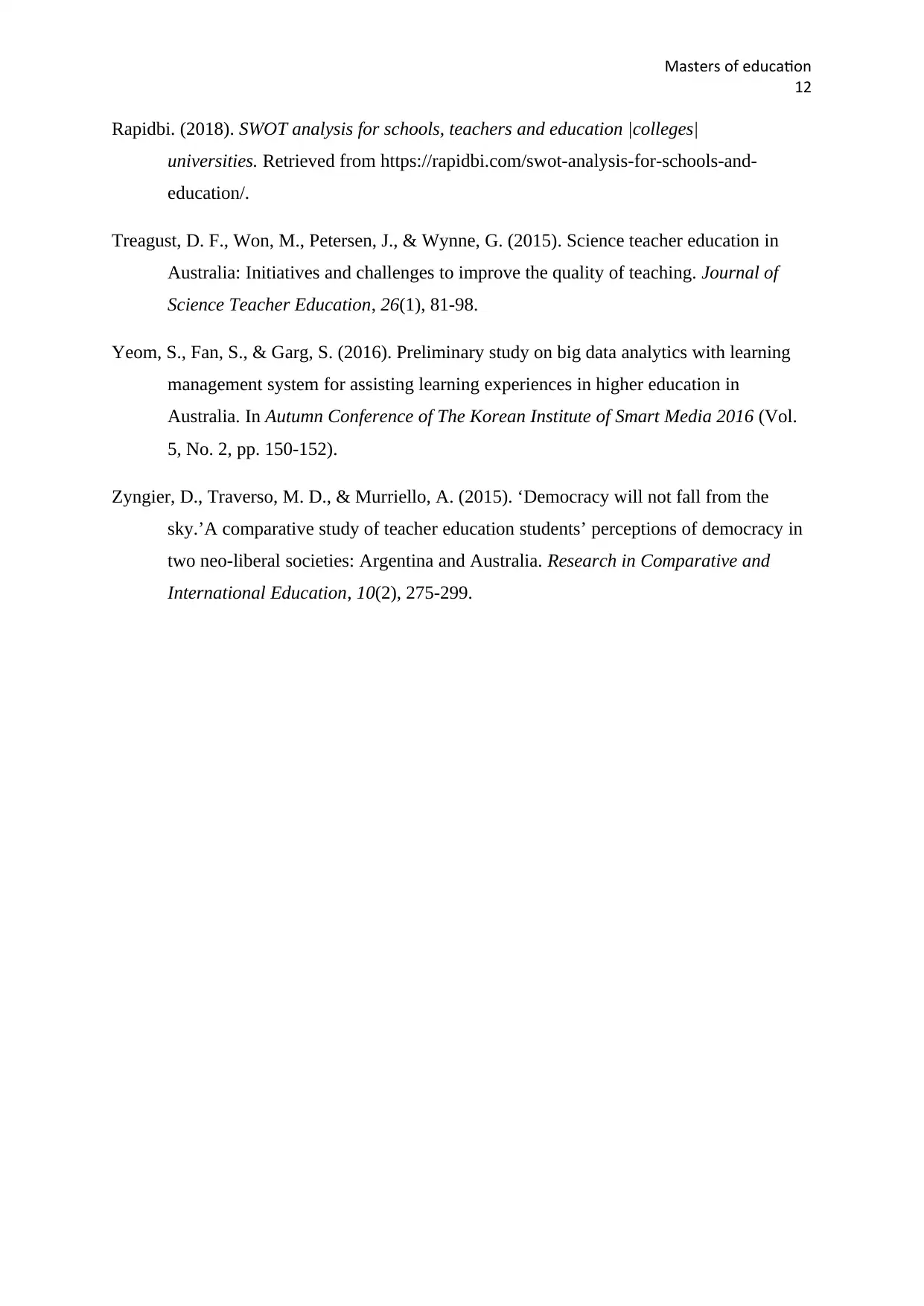
Masters of education
12
Rapidbi. (2018). SWOT analysis for schools, teachers and education |colleges|
universities. Retrieved from https://rapidbi.com/swot-analysis-for-schools-and-
education/.
Treagust, D. F., Won, M., Petersen, J., & Wynne, G. (2015). Science teacher education in
Australia: Initiatives and challenges to improve the quality of teaching. Journal of
Science Teacher Education, 26(1), 81-98.
Yeom, S., Fan, S., & Garg, S. (2016). Preliminary study on big data analytics with learning
management system for assisting learning experiences in higher education in
Australia. In Autumn Conference of The Korean Institute of Smart Media 2016 (Vol.
5, No. 2, pp. 150-152).
Zyngier, D., Traverso, M. D., & Murriello, A. (2015). ‘Democracy will not fall from the
sky.’A comparative study of teacher education students’ perceptions of democracy in
two neo-liberal societies: Argentina and Australia. Research in Comparative and
International Education, 10(2), 275-299.
12
Rapidbi. (2018). SWOT analysis for schools, teachers and education |colleges|
universities. Retrieved from https://rapidbi.com/swot-analysis-for-schools-and-
education/.
Treagust, D. F., Won, M., Petersen, J., & Wynne, G. (2015). Science teacher education in
Australia: Initiatives and challenges to improve the quality of teaching. Journal of
Science Teacher Education, 26(1), 81-98.
Yeom, S., Fan, S., & Garg, S. (2016). Preliminary study on big data analytics with learning
management system for assisting learning experiences in higher education in
Australia. In Autumn Conference of The Korean Institute of Smart Media 2016 (Vol.
5, No. 2, pp. 150-152).
Zyngier, D., Traverso, M. D., & Murriello, A. (2015). ‘Democracy will not fall from the
sky.’A comparative study of teacher education students’ perceptions of democracy in
two neo-liberal societies: Argentina and Australia. Research in Comparative and
International Education, 10(2), 275-299.
1 out of 13
Related Documents
Your All-in-One AI-Powered Toolkit for Academic Success.
+13062052269
info@desklib.com
Available 24*7 on WhatsApp / Email
![[object Object]](/_next/static/media/star-bottom.7253800d.svg)
Unlock your academic potential
© 2024 | Zucol Services PVT LTD | All rights reserved.





